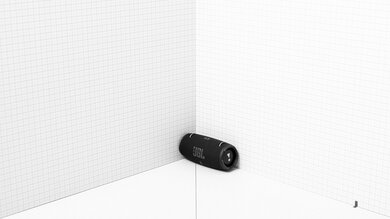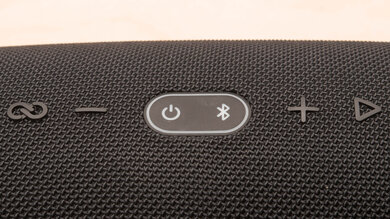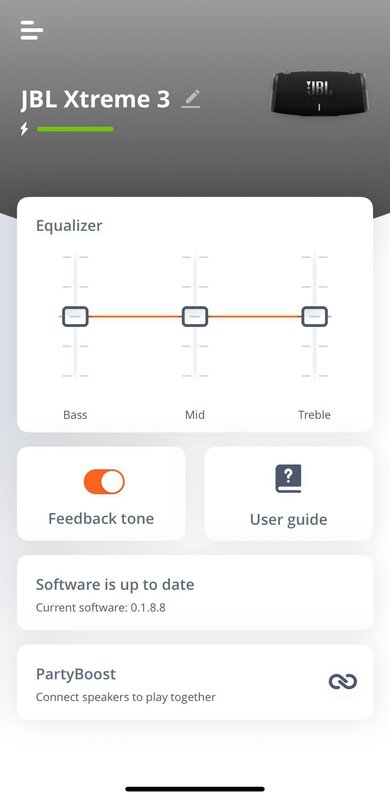The JBL Xtreme 3 is the third generation in JBL's Xtreme lineup of rugged Bluetooth speakers. It has a similar design to the JBL Xtreme 2, with built-in hooks to help you carry it while on the go and a built-in bottle opener attached to the carrying strap. It's designed to bring the party with you, whether you're in or out of the house. It has a solid build and an IP67 rating for water resistance to protect it against the elements. However, this speaker doesn't include voice assistant support like its predecessor.
Our Verdict
The JBL Xtreme 3 is alright for music. Out of the box, it reproduces voices and lead instruments with relative clarity, so it's suitable for a wide range of music genres. That said, a dip in the treble adds a dull quality to the sound, though you can use its graphic EQ to make up for this a bit. Given its small size, you don't get a deep rumble in the low-bass, either.
- Well-built and portable.
- Plays stereo content.
- Lacks low-bass.
- Compression artefacts at max volume.
The JBL Xtreme 3 isn't designed for use with videos and movies, but if you want to use it while streaming videos and movies on your phone, it's a suitable choice. You can pair it with up to two devices at once, and its clear reproduction of dialogue means it's easy to follow the action on screen. There are some lip-synching issues, and the lack of low-bass doesn't provide a very cinematic feel.
- Well-built and portable.
- Lacks low-bass.
- Doesn't support Apple AirPlay, Chromecast, or Wi-Fi.
- Compression artefacts at max volume.
The JBL Xtreme 3 is decent for podcasts. Dialogue reproduces with clarity right out of the box, so you can easily follow along with your favorite shows. The speaker can easily move around with you from room to room, too, and its wide range helps it stay connected to your phone even when you're further away. There's a dip in the treble out of the box that adds a dull quality to vocals, but you can use its graphic EQ to make up for this.
- Supports multi-device pairing.
- Well-built and portable.
- Compression artefacts at max volume.
- Doesn't support multi-room.
The JBL Xtreme 3 doesn't have voice assistant support, a feature that was included with the previous generation JBL Xtreme 2.
The JBL Xtreme 3 is very good for outdoor use. It's a portable Bluetooth speaker designed to withstand the elements, whether you're camping or enjoying an afternoon at the park. It has a sturdy and durable build, as well as an IP67 rating for dust and water resistance to help it withstand exposure to the elements. It also gets very loud, meaning you can easily blast your favorite tunes across your backyard.
- Supports multi-device pairing.
- Well-built and portable.
- IP67 rating for dust and water resistance.
- Lacks low-bass.
- Compression artefacts at max volume.
Changelog
- Updated Aug 01, 2024: We've added a comparison between this speaker and the JBL Xtreme 4 in Battery.
- Updated Jan 23, 2024: We've updated this review for accuracy and clarity and added relevant comparisons.
- Updated Jun 29, 2023: Added market comparison with the Tribit StormBox Blast in the Battery box.
- Updated Jan 17, 2023: Updated review text for accuracy and clarity. No changes in test results.
Check Price
Differences Between Sizes And Variants
This speaker comes in three color variants: 'Black', 'Blue', and 'Black Camo'. We tested the 'Black' variant, and you can see its label here. We expect all color variants to perform similarly to our model.
If you encounter another variant, please let us know in the comments, and we'll update our review.
Popular Speaker Comparisons
The JBL Xtreme 3 is a medium-sized portable speaker that's smaller and more portable than the JBL Boombox 2. Like its predecessor, the JBL Xtreme 2, it has built-in hooks to attach the included carrying strap. The strap even comes with a built-in bottle opener, so you can enjoy drinks while listening to your favorite music. That said, unlike its predecessor, it doesn't support voice assistants. You can also use the speaker as a power bank if your smartphone or other device needs recharging, similar to the JBL Charge 5.
See our recommendations for the best Bluetooth speakers, the best portable Bluetooth speakers, and the best Bluetooth speakers for bass.
The JBL Xtreme 4 is the latest version of the JBL Xtreme 3 and features small upgrades that can be significant to some users. The biggest upgrade comes in the form of a 27-hour battery life that doubles that of its predecessor. There's also support for Auracast, so you can pair other compatible speakers, as well as support for Bluetooth version 5.3. Beyond this, there are marginal improvements in frequency response and dynamics. Both speakers are rated IP67 for protection against dust damage and can be submersed in water, meaning they're both great choices for bringing with you to the great outdoors.
The JBL Xtreme 3 and the JBL Charge 5 are very similar speakers. While they both have very similar designs, the Charge 5 is smaller, lighter, and more portable. It also has a slightly better-balanced sound profile. However, the Xtreme 3 can play stereo content without downmixing it to mono, which sounds more immersive. It uses the JBL Connect app, unlike the Charge 5, which uses the JBL Portable app.
The JBL Xtreme 2 is a better speaker than the JBL Xtreme 3. They have very similar builds, but the Xtreme 2 has a slightly more balanced sound profile and a longer battery life. Also, only the Xtreme 2 has voice assistant capabilities. Although the two speakers can get similarly loud, the Xtreme 2 has fewer compression artifacts present at max volume.
The JBL Boombox 3 is a better speaker than the JBL Xtreme 3. The Boombox 3 has a more balanced sound profile that produces a more extended low-bass. It gets louder than the Xtreme 3, with significantly less compression at max volume, so audio quality sounds cleaner and clearer when you blast your favorite songs. It also has a much longer-lasting battery life of almost 30 hours on a single charge. That said, the Xtreme 3 is smaller and more portable. Its removable carrying strap even comes with a bottle opener built in to enjoy drinks with friends.
Test Results

The JBL Xtreme 3 is a medium-sized cylindrical speaker that you can place vertically or horizontally. It has two built-in low-profile hooks on its top side so you can attach its carrying strap. Like the TREBLAB HD-Max, the carrying strap has a built-in bottle opener, so you can enjoy drinks while listening to your favorite tunes. It comes in three colors, so you can find a look that suits your style.
This battery-powered speaker has built-in hooks, so you can attach its removable carrying strap and bring it along when you're on the move. While it's lighter than the JBL Xtreme 2, it's still quite hefty for a portable speaker. For a similar JBL speaker that's even more portable, check out the smaller JBL Charge 5.
This speaker's build quality is great. It has an IP67 rating for dust and water resistance that certifies it to be fully dust-tight and immersible in up to a meter of water for 30 minutes. As a result, you can use it near water without worrying too much about damage. It's wrapped in tight and sturdy netting, and its base and sides are made of rubber to keep the speaker from slipping when placed horizontally or vertically. Also, there are built-in hooks so you can attach its carrying strap. The strap feels sturdy, and it has a built-in bottle opener.
The controls are easy to press, and it has simple music management features like volume control and a play/pause button. You can also press the play button twice to skip to the next track, but unfortunately, you can't backtrack. On the upside, there's a chime when you've reached max volume. The power and Bluetooth buttons light up, and there's a small, vertical indicator for battery life under the JBL logo. This speaker has a dedicated 'PartyBoost' button, meaning you can connect with multiple PartyBoost-compatible speakers.
The speaker's frequency response is fairly even and balanced out of the box, especially in the mids, where most voices and lead instruments reproduce. It's a good choice for listening to most music genres and dialogue-heavy content like podcasts and audiobooks. The dip in the treble means that the audio is a bit dull, though. Also, given its small size, you don't get the deep thump and rumble in the bass compared to larger speakers on the market. That said, there's a graphic EQ available through the app, so you can tweak the sound to suit the audio you're listening to.
Its soundstage performance is satisfactory. It can play stereo content without downmixing it to mono, meaning you can distinguish between its left and right channels. However, its directivity is mediocre, resulting in a narrow soundstage that sounds inconsistent when listening from different angles. There's also some overemphasis in the treble range, which can cause the soundstage to seem uneven.
The speaker can get fairly loud, and its sound can fill a large room. However, there's a lot of compression present at max volume, so your audio isn't as clean or clear when the speaker is pushed to its louder volume levels. There will also be some pumping artifacts.
The speaker has an outstanding battery performance. It's advertised to last around 15 hours off a single charge, but it actually lasts around 12 hours. Battery performance can vary depending on your usage, and your experience may differ. A handy power-saving feature shuts the speaker off after 20 minutes of inactivity. If you want a speaker that lasts longer off a single charge, check out the Tribit StormBox Blast or this speaker's successor, the JBL Xtreme 4.
The JBL Portable app is very good. It's compatible with both iOS and Android. You can use it to link to two PartyBoost-compatible speakers to create a stereo pair or connect it with multiple speakers to play the same audio across a large space. You can also use the graphic EQ to customize the speaker's sound profile.
The JBL Xtreme 3 has a USB-C port to charge the speaker and a USB-A port to charge your other devices, like your phone. Also, there's an AUX port, meaning you can use a wired connection between this speaker and your smartphone. However, this cable doesn't come in the box.
You can pair this speaker with up to two devices at a time, and it has a wide range to stay connected as you move away from your phone. Its latency on iOS and Android is alright, and it can be a suitable choice for watching videos. However, some apps and devices compensate for latency differently, so your experience may vary. For a portable speaker with a better Bluetooth latency performance overall, check out the Sony SRS-XG300.






